Don't Be Afraid To Ask (Your Students) Questions
- By Brandon Barrett
- 06/01/14
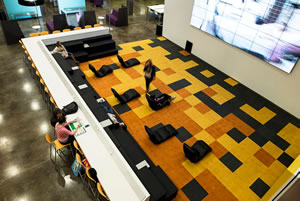
PHOTOS COURTESY OF KSQ ARCHITECTS
A college is only good as the furniture in its classrooms. Okay, so maybe there is a bit more to the equation than that, but it is impossible to deny that the equipment inside a college facility can surely impact students’ attitudes and ability to learn effectively. While many colleges and universities spend large amounts of money on creating an outdoor sense of “curb appeal” on their campuses, a great set of chairs and desks can catch a prospective student’s eye almost as quickly.
When attempting to plan a campus furniture overhaul, things can quickly become overwhelming. Which classrooms/spaces should be given preferential treatment? How can colleges and universities get the most out of tight furniture budgets in a way that benefits students and faculty? The easiest way is to obtain lots and lots of campus community feedback about what is working and what isn’t furniture-wise. Ask students and faculty what they would like to see added to classrooms, and even what they would remove if given the choice. The answers might just surprise you.
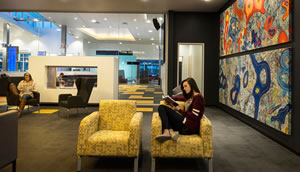
PHOTOS COURTESY OF KSQ ARCHITECTS
Customizing Classrooms
One furniture trend that has been picking up steam is tailoring classroom and facility furniture to the subjects and atmosphere of the courses taught there. Such a strategy helps to not only position an institution as a place that takes student comfort and well-being seriously, it can also help students and faculty to get more out of their in-class time. Take, for instance, a classroom in which writing courses are taught. Having a large center-table can give students and their professors a place to provide peer feedback and discuss assignments as a group. Courses can be enhanced by the comfort-level of all involved.
When he first visited Sinclair Community College in Dayton, OH, current sophomore Jacob Duffy noticed the furniture and had a generally positive feeling about it. He also noticed that some furniture was arranged specifically for subjects taught in certain classrooms. While the idea of specialized classrooms is nothing new in the world of science education, customizing classrooms for other academic endeavors, as Sinclair is doing, can make just as much difference.
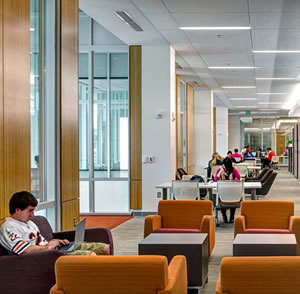
QUIET, PLEASE. Although there is a trend in library design to increase the amount of group study space to accommodate shared work, students feel that these group spaces should not be at the expense of quiet spaces. Students consistently gravitate to quiet areas in campus libraries. The desire for quiet, contemplative study is as strong as ever, so a mix of noise-dampening (soft) furniture and collaborative spaces is ideal.
Likewise, customizing furniture for non-classroom environments can easily win the favor of students. Victoria Irvin, a junior at Southeastern University in Lakeland, FL, seconds this idea. “I like the furniture in the library because it’s more comfortable [than in other areas] and I sit in there for multiple hours,” she says. Ensuring a building’s furniture matches its purpose can help create a positive environment for living and learning.
Students Take Notes
What do students notice aside from tailoring furniture to facility type and subject matter? Classroom space seems to be next on the list of considerations. Madelyn Steger, a freshman at Valencia College in Orlando, notes this fact quite clearly when asked about what works and what doesn’t furniture-wise. “Students need lots of desk space and to be not so close to other students… I like that our desks are very efficient for taking notes and tests, without being too crowded,” she says.
Another thing students appreciate is when a college has unique furnishings that help it to stand out from other institutions in some way. “We have hammocks all over campus and I really enjoy that,” says Irvin when asked about Southeastern University’s on-campus furnishings. Although small touches like hammocks or pillows may seem trivial next to big-ticket items, they really seem to make a difference to students.
In addition, students are able to notice things that could escape the eye of even the most seasoned administrator. Jacob Duffy says the furniture is generally nice, but has noticed an issue in the dining hall. “The one thing I dislike about the furniture is that some of the dining room tables wobble and it really is nerve-wracking when your drink spills when you touch the side of the table,” he says.
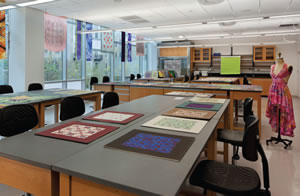
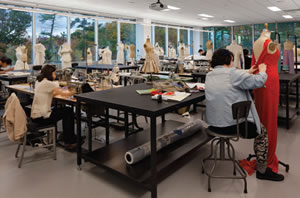
PHOTOS COURTESY OF GRUZEN SAMTON - IBI GROUP
DON’T CROWD ME IN. Students prefer furniture that allows them a comfortable amount of personal space, with desk or table surfaces with sufficient room for test- and notetaking, as well as their laptops or other mobile devices. Also, there is, in students’ opinions, no such thing as too much outdoor seating on any campus.
While many schools focus on indoor and classroom furnishings, recent University of Central Florida graduate Alyssa Steger thinks that outdoor furniture is important and often noticeable. “We [the students] need more benches to sit outside around campus,” says Alyssa. Sentiments such as this drive home the fact that College and University administrators should think of campus furnishings from the inside out. Students do, and at times, it can be the first thing they might notice about your school.
Expectations of Excellence
Schools might hire outside consulting firms to gather this kind of information, but sometimes the most valuable insights can be found by simply asking, as illustrated by students like Jacob and Alyssa. Aside from gaining information about what is working and not working when it comes to furniture, it can be helpful for colleges just to understand what students expect facilities to provide.
Student Chelsea McFarland of Miami University in Oxford, OH, makes her expectations clear, stating, “I would expect the furniture to be comfortable, but stylish and easy to clean as well.” With expectations ranging from aesthetic to cleanliness, students certainly seem to know what they want when they arrive on campus.
“I expect college furniture to be in tip top shape, since we the students pay for the tuition and indirectly, for the furniture,” adds Duffy. What students expect to see furniture-wise and what they actually see on campus can sometimes make a world of difference when they visit for the first time. If your furniture is outdated and worn, students will notice and all your effort put toward a great campus tour could be wasted.
Graduate students sometimes have special expectations when coming to campus. University of Arizona graduate student Calley Eads notes this when asked about her furniture expectations. “I want the desks to be spaced out in a way that promotes mobility but in a way that also allows students to interact with group members and other students near by,” says Eads, who teaches, studies and proctors exams at the university. Given the versatile nature of their aims and daily tasks, graduate students can be a great, yet sometimes overlooked, resource for furniture and facility insights.
Furniture, while it may not seem like a deal-breaker, can be for some students. Students are able to choose to attend school anywhere and, aside from curb appeal, your furniture can be the next most important selling point when it comes to facilities. Without it, you will be left trying to sell a great academic program without the facilities and furniture that truly make it possible.
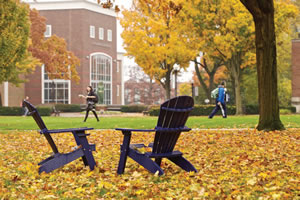
PHOTO COURTESY OF LEBANON VALLEY COLLEGE
DON’T BE AFRAID TO ASK
If you are searching for examples of schools that have benefited from seeking a student perspective, it won’t take long to find convincing results. At the University of Southern California, for example, the Undergraduate Student Government surveyed students about issues pertaining to the Leavey Library, one of two main research libraries on campus.
After surveying several students, it was discovered that the library didn’t necessarily need a complete renovation. It simply needed furniture and space updates to match student needs. After the survey, money could be more appropriately allocated for the update. Read more about the process at dailytrojan.com.
At the University of Florida, students were given the opportunity to help choose furniture for the recreation area in the Reitz Union. Students were able to vote for their favorite pieces, as well as voice what they desired in new facility furniture. Students voted online and in-person in a “furniture tournament” set-up where the losing pieces were eliminated and the winners advanced, making the process both fun and useful. Read more at alligator.org.
Clark College in Vancouver, WA, also gathered student opinions about potential library furniture. The college was able to obtain “sample” furniture that students could use and provide feedback on before the school made any purchasing decisions.
The original story, along with details, can be found on the Clark College Libraries Blog.
This article originally appeared in the issue of .